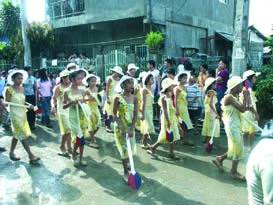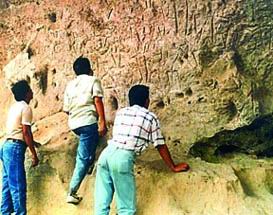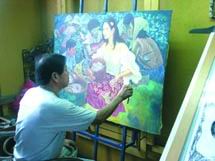| |
| |
| ----------------------------- |
|
|
|
| |
| tourism |
| |
| Destination:
Angono |
 |
|
About
40 kilometers southeast of Manila is the former
sleepy town of Angono. Formerly a part of another
Rizal town, Binangonan, the 236-year-old Angono
can be reached from Manila via the Pasig-Cainta
Floodway or through Ortigas via Cainta and Antipolo.
Angono celebrates the feast
of its patron saint San Clemente every 23rd of November.
Another festive time to visit Angono is during the
towns fiesta on 22-23 November. A parade of gigantes
(giant papier-mâché puppets crafted
by the town’s artisans) and a fluvial procession
in honor of San Clemente highlight the fiesta. |
| A
group of costumed girls parade in Angono’s
San Clemente fiesta every November. |
| |
| |
|
|
| During
the Holy Week, the town people perform the Christian tradition
Salubong at the crack of dawn on Easter Sunday. The event
involves giant bird puppets maneuvered to open a flower
containing a young girl. The flower is lowered and then
the girl removes the veil of mourning from Mary as she
passes by. |
| |
Petroglyphs
In 1965, National Artist
for Visual Arts Carlos “Botong” Francisco
discovered some 127 carvings engraved on the wall
of a shallow cave in Angono, Rizal. The Angono petroglyphs,
as they are called, are said to be the oldest known
artworks in the Philippines, dating from the 3rd
millennium, BC. The 3,000-year old carvings are
line incisions of human figures, with the circular
heads set on top of rectangular or V-shaped bodies.
The figures are without necks but with arms and
legs. Whoever carved the figures may have also carved
the geometric figures that also appear |
|
 |
| Rock
art. The Angono petrogylphs is managed by the National
Museum. It is open to visitors from 8 a.m. to 5
p.m., Mondays to Saturdays. |
| |
|
|
|
on the rock
wall: rectangles, triangles and circles. Most of the carvings
have been eroded by rain, the harsh sunlight, and the
wind.
Others have been destroyed by vandals and visitor traffic.
According to anthropologist Dr.
Jesus Peralta, “The engraved drawings are made without
any reference to a baseline, suggesting that these were
made during different points in time.” Stylized
anthropomorphic and zoomorphic forms are etched in the
rock shelter.
The Angono Petroglyphs are listed in the World Inventory
of Rock Art. In 1996, it was also included in the World
Monuments Watch, a list of the 100 Most Endangered Sites
in the World. Established in 1995 by the World Monuments
Fund, a private worldwide organization that preserves
cultural sites. |
| |
 |
|
Artists
Haven
Perhaps, the rock carvers
were the ancestors of modern day Angono people because
the town is home to many artists, including Francisco.
At the Blanco Family house gallery located at Ibañez
Street, one may see the impressive works of three
generations of the gifted Blanco family. Also of
interest are Nemiranda’s home-gallery-school
at Dona Elena Street and the late Perdigon Vocalan’s
Balaw-balaw Restaurant and Art Center. The restaurant,
which is made of old wood, is |
| Nemiranda
finishing Sampaguita Gatherers. |
| |
|
|
|
adorned with
Perdigon’s paintings, sculpture and other art works.
Angono is also the home of Lucio
San Pedro, national artist for music, and founder of the
Angono Symphonic Band. |
| |
 |
|
Balaw-Balaw
Balaw-Balaw Restaurant derived its name from the
namesake sauce made of small shrimps mixed with
gruel and angkak (a herb that gives reddish coloring),
which, for time immemorial, has been popular in
Angono. The sauce is fermented in an earthen jar
for three days after which it is ready to eat
or sauted with young bamboo shoots.
Established by the late
artist-chef-interior designer Perdigon Navarro
Vocalan in 1982, the restaurant is now managed
by his wife, |
| Sinigang
na kanduli sa miso and minaluto. |
| |
|
|
|
Luzvimin Vocalan,
a former high school teacher. It offers traditional Angono
recipes such as fried itik (native duck marinated with
spices and fried to a crisp); sinigang na kanduIi with
soybean curd soured with tamarind extract served with
balaw-balaw; dinilawang kanduli or palos (eel) cooked
in yellow ginger (turmeric) and fragrant alagaw leaves;
barutak, made from pounded shrimp heads and tamarind extract
and different vegetables; sinabawang balut with buntot
ng baka, duck eggs with cowtail and herbs; nilasing na
hipon or palaka shrimps, frogs marinated in wine and deep
fried; pinalapot sa gata, different dishes cooked in coconut
milk.
A hit among diners is the minaluto.
The term means packed meal or baon in which the rice and
viand are packed together and wrapped in banana leaves.
Balaw-Balaw’s minaluto is a heaping mound of newly
cooked rice topped with pork and chicken adobo, surrounded
by steamed mussels, crabs, tiger prawns, oysters, fried
pork chop, squid rings, chicken meat, fried fish, sauted
kangkong leaves, gumbo or okra, red egg and tomato. Balaw-Balaw
Restaurant has also become popular for its scrumptious
and exotic dishes such as adobong sawa (python) sa bawang
or gata, adobong bayawak (Chicken Lizard) sa bawang or
gata, tapa ng baboy damo (wild boar) and usa (deer), adobong
palaka (frogs), and palos (eel) cooked as adobo and dinilawan.
Best seller too is the ginisang
balaw-balaw and burong dalag or hito or kanduli. The restaurant
also whips up native salads such as ensaladang labanos,
which are squeezed the old fashioned way but made more
savory with their own sweet-sour sauce garnished with
bits of tinapa (smoked fish) and chopped sibuyas tagalog
(challots). There are also ensaladang kamias, pinaksiw
na ampalaya (slices of bitter gourd, raddish and eggplant
cooked in sweet-sour sauce), ensaladang talong (grilled
eggplant with vinegar and coconut milk). |
| |
| Cebu
Pacific flies daily to Changi, Singapore |
The
Philippines air transport industry soared to new heights
as the country’s second largest air carrier established
regular flights to Singapore.
Cebu Pacific Air now calls at
the Changi Airport. In its recent maiden flight to the
airport, Cebu Pacific unloaded Filipino passengers led
by Lance Gokongwei, chief executive officer of CPAir.
They were welcomed by Singapore’s famed lion dance.
Singapore aviation officials hailed
the new air service saying it would further improve trade
between the two countries.
“The services of Cebu Pacific
Air will enhance the existing extensive trade and tourism
links between our two countries,” Ho Beng Huat,
acting director-general of civil aviation, said.
On the other hand, the addition
of another airline to the ranks of those operating at
Changi was seen as strengthening Singapore’s position
as an aviation hub in the region. Changi is linked to
140 cities in 49 countries by 61 airlines.
Cebu Pacific Air will operate
daily scheduled flights between Singapore and Manila,
increasing Changi’s connectivity to Manila from
35 to 42 weekly scheduled flights. |
| |
| Marine
life finds sanctuary at Hundred Islands |
Marine
life at the the Hundred Islands National Park (HINP) can
now heave a sigh of relief. After years of wanton destruction
brought about by illegal fishing practices and carelessness,
the Protected Area Management Board (PAMB) of Pangasinan
finally declared areas of the HINP a fish sanctuary.
In a resolution passed by the
board, PAMB said that all forms of fishing is now prohibited
in the 265,209-square meter park to resuscitate its dying
marine ecosystem.
The protected area covers only
a portion of the 1,844-hectare park to ensure that fisherfolks
from the coastal communities are not deprived of their
continuous source of livelihood.
Authorities said the fishing communities
of HINP would be the ultimate beneficiaries of the restoration
zone. Drawing inspiration from the marine conservation
program being done at the Apo Island, PAMB said the fish
sanctuary would not only increase the fish catches of
HINP fishermen but would also enhance the park’s
marine bio-diversity and thus, would also bring in tourism.
The fish sanctuary shall be under
strict protection from all fishing as well as human activities
except for scientific studies, research, restoration activities
and controlled tourist viewing, diving and snorkeling
activities.
The covered zone shall be properly
demarcated with buoys to warn ships against anchoring
or the throwing of anchor in these areas. Mooring, the
tying of boats to buoys, shall only be allowed in designated
areas to protect the transplanted corals in the area and
prevent the disturbance of the underwater eco-system.
A maximum fine of P500,000 and
imprisonment of not more than six years shall be imposed
against persons who shall fish or hunt in the protected
area. |
| |
|
|
|
|
|
|
|
|
|
|
|
|
|
|


